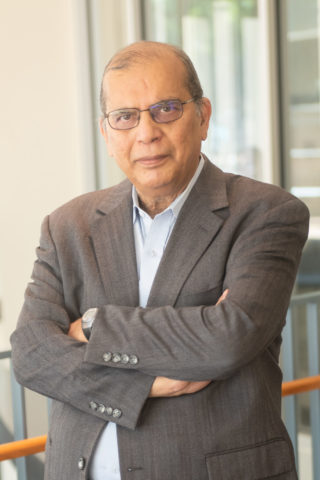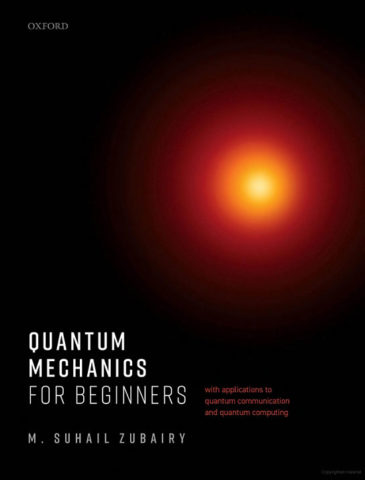Texas A&M Physicist Leads Charge to Help Freshmen Master Quantum Mechanics
Texas A&M University physics professor M. Suhail Zubairy once proposed a scenario to his freshman class: If he were to throw a ball against a wall, common sense tells us that there is no probability it can go through the wall to reach the other side. But by the principles of quantum mechanics, under certain conditions, it is possible.
“Do you believe this to be true?” he asked the class.
One student who knew better raised his hand. “Dr. Zubairy, I’ll believe anything you tell me about quantum mechanics.”

It’s the murky scientific conjectures of quantum mechanics that indeed require an open mind — and even one of the greatest, renowned theoretical physicist Albert Einstein, was bewildered by them. Zubairy’s hypothetical situation with the ball is but one example of the many phenomena possible under the perplexing yet fascinating rules of quantum mechanics, a fundamental theory in physics describing the behavior of matter and energy on the atomic and subatomic scale typically considered so advanced that it’s often not taught to college students until their junior or senior years.
Zubairy, a distinguished professor of physics and astronomy and inaugural holder of the Munnerlyn-Heep Chair in Quantum Optics, is leading a charge at Texas A&M to revise that perception. Since 2017, Zubairy has been bringing freshmen to the frontier of quantum mechanics through his PHYS 148: Introduction to Quantum Mechanics course.
At the quantum level, atoms and photons behave in a seemingly erratic manner — sometimes as particles, sometimes spread out as waves. Researchers have been probing these bizarre microscopic occurrences to make unprecedented and revolutionary developments in industrial science. As Zubairy sees it, with no sign of the race to harness the full potential of quantum technology slowing down, the sooner students are exposed to the field, the better.
“Quantum mechanics is a highly successful theory — a very strange but remarkable theory,” Zubairy said. “Almost 100 years have passed, and there has not been a single experiment that contradicts its predictions; that’s a big success. This hasn’t happened with any other physics theory in human history, except for Einstein’s theory of relativity.”
Traditional quantum mechanics courses are highly abstract and require an advanced knowledge of mathematics, particularly calculus. Zubairy opted to design an alternative curriculum that taught the basic principles of quantum mechanics in a way that was almost entirely algebra-based and comprehensible to anyone with a high-school-level understanding of math.

Describing his new course as “one of the most challenging yet fulfilling” of his 40-plus-year career, Zubairy says students will gain a fundamental understanding of the conceptual foundations of quantum mechanics as well as the rapidly emerging fields of quantum computing and quantum communication. Considering he wrote the course textbook on it — “Quantum Mechanics for Beginners: With Applications to Quantum Communication and Quantum Computing” — he should know.
“It’s not a history course,” Zubairy said. “We go into each topic in great mathematical detail, except that these mathematical details are very simple. We do not go into conventional quantum mechanics where you’re trying to solve real problems using highly sophisticated mathematical tools, but rather, we talk about how some of those conceptual foundations are leading to new developments in the emerging field of quantum technology.”
While the book is assigned reading for Zubairy’s freshman course, its broad appeal extends to Texas A&M physicist and Department of Physics and Astronomy head Grigory Rogachev, who marvels at Zubairy’s ability as both a writer and an educator.
“Professor Zubairy is simultaneously teaching two quantum mechanics courses at two completely different levels — introductory for freshmen and a highly specialized senior graduate course, using textbooks he wrote himself in both cases. We do not normally consider quantum mechanics as a subject suitable for freshman. Surprisingly, he created a course that is quite popular with freshman students and describes complicated issues of quantum mechanics at an appropriate and rather accurate level. Students love it, and the book is very well written. I have it on my desk.”
The origins of quantum mechanics dates back to the turn of the 20th century when German physicist Max Planck first proposed the idea that energy does not flow in a continuum as classic Newtonian physics suggests; rather, it exists in discrete units. Although controversial at the time, the idea of quantum mechanics continued to gain momentum, and its basic principles have been leveraged by researchers to make revolutionary advances in a wide range of systems, including faster, more secure electronics.
“With this idea of quantum technology, some of the very simple concepts of quantum mechanics are being used to accomplish big things,” Zubairy said. “This is something that we’re only realizing now in the 21st century. People are expecting that this is really going to influence how technology develops in the future.”
Zubairy, who joined the Texas A&M faculty in 2002, is a member of the Institute for Quantum Science and Engineering (IQSE) and is considered a leading expert in the fields of quantum optics, quantum communication and quantum computing. A fellow of the Pakistan Academy of Sciences, American Physical Society and Optical Society of America, he has received many honors, including the Willis E. Lamb Award for Laser Science and Quantum Optics, the Alexander von Humboldt Research Prize for Distinguished Scientists and the George H.W. Bush Award for Excellence in International Research. Along with IQSE Director Marlan O. Scully, a fellow distinguished professor of physics and astronomy and a pioneer in quantum optics and laser physics, Zubairy also coauthored the 1997 textbook “Quantum Optics.”
Close friends and colleagues since the 1970s, Scully commended Zubairy’s efforts to broaden the accessibility of quantum mechanics and his ability to connect a younger audience with such an abstract subject.
“Suhail has been instrumental in everything that we’ve done,” Scully said. “He’s always had the physics sharply in focus and done beautiful scientific work, and he has an excellent mind for what the student needs to hear and learn. It takes a master teacher to do that.
“They don’t call him ‘distinguished professor’ for nothing.”
The IQSE, which has become a global leader in groundbreaking research initiatives that impact everything from medicine to national security, boasts a multidisciplinary contingent of world-class researchers, including two Nobel Prize winners. Edward S. Fry, himself a distinguished professor of physics and astronomy at Texas A&M who is renowned for his work in quantum mechanics and quantum optics, notes that Zubairy’s vision for this course demonstrates the IQSE’s commitment not only to conducting high-caliber research but also to preparing the next generation of quantum theorists.
“The general consensus is that quantum mechanics is something you can’t handle until you’ve taken at least three years of physics,” Fry said. “I was really amazed when I heard Suhail was teaching quantum mechanics to freshmen. It’s a testament to the amazing group of people we have here at the IQSE.”
A native of Pakistan, Zubairy earned his master’s in physics from Quaid-I-Azam University in 1974 and his doctorate in physics from the University of Rochester in 1978. Zubairy had already made up his mind to pursue a career in physics while still in high school, but it was as an undergrad at Quaid-I-Azam that his vision for a beginner level quantum mechanics course began taking shape.
Zubairy recalls that his disappointment when the subject was never mentioned in his early college courses only fueled his determination to one day create a quantum mechanics course for freshmen. Nearly 50 years later, Zubairy has been able to realize his dream.
“To my knowledge, such a course has never been offered anywhere else in the world,” Zubairy said. “My students might be the only 18-year-olds in the world who can explain what quantum mechanics is as well as what quantum computing is. I’m very happy to have such wonderful students and such wonderful opportunities.”
-aTm-
Contact: Chris Jarvis, (979) 845-7246 or cjarvis@science.tamu.edu or Dr. Suhail Zubairy, (979) 862-4047 or zubairy@physics.tamu.edu
The post Texas A&M Physicist Leads Charge to Help Freshmen Master Quantum Mechanics appeared first on Texas A&M College of Science.
